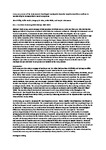A new occurrence of the Early Jurassic brachiopod Anarhynchia from the Canadian Cordillera confirms its membership in chemosynthesis-based ecosystems
| dc.contributor.author | Palfy, J | |
| dc.contributor.author | Kovács,, S | |
| dc.contributor.author | Watanabe, Sayaka | |
| dc.contributor.author | Vörös,, A | |
| dc.date.accessioned | 2017-10-24T16:06:38Z | |
| dc.date.available | 2017-10-24T16:06:38Z | |
| dc.date.issued | 2017-10-24 | |
| dc.identifier.issn | 0008-4077 | |
| dc.identifier.issn | 1480-3313 | |
| dc.identifier.uri | http://hdl.handle.net/10026.1/10088 | |
| dc.description.abstract |
<jats:p> Cold seeps, where seepage of hydrocarbon-rich fluids occurs in the sea floor, are sites that harbor highly specialized ecosystems associated with distinctive carbonate sediments. Although their Mesozoic record is scarce and patchy, it commonly includes dimerelloid rhynchonellide brachiopods. Here we report a monospecific assemblage of Anarhynchia from a limestone boulder of early Pliensbachian (Early Jurassic) age in the Inklin Formation of the Whitehorse Trough in the Stikine terrane, from a locality at Atlin Lake in northern British Columbia. Specimens are among the largest known Mesozoic brachiopods, up to 9 cm in length, and described here as Anarhynchia smithi n. sp. Early precipitated carbonate cement phases of the limestone have carbon isotopic composition highly depleted in <jats:sup>13</jats:sup>C, indicative of the influence of microbial oxidation of methane derived from a cold seep. Carbonate petrography of the banded-fibrous cement and other characteristic components supports this paleoenvironmental inference. Volcanogenic detrital grains in the matrix are indistinguishable from those in the sandstone layers in the siliciclastic sequence, suggesting that the seep carbonate is broadly coeval with the enclosing conglomerate. The new record extends the geographic range and species-level diversity of the genus, but supports its endemism to the East Pacific and membership in chemosynthesis-based ecosystems. The distribution of three distinct but congeneric species suggests that allopatric speciation occurred at separate sites along the active margin of western North America and Anarhynchia was restricted to seep and vent habitats in the Early Jurassic. </jats:p> | |
| dc.format.extent | 1179-1193 | |
| dc.language | en | |
| dc.language.iso | en | |
| dc.publisher | NRC Research Press | |
| dc.title | A new occurrence of the Early Jurassic brachiopod Anarhynchia from the Canadian Cordillera confirms its membership in chemosynthesis-based ecosystems | |
| dc.type | journal-article | |
| dc.type | Journal Article | |
| plymouth.author-url | https://www.webofscience.com/api/gateway?GWVersion=2&SrcApp=PARTNER_APP&SrcAuth=LinksAMR&KeyUT=WOS:000415758600001&DestLinkType=FullRecord&DestApp=ALL_WOS&UsrCustomerID=11bb513d99f797142bcfeffcc58ea008 | |
| plymouth.issue | 12 | |
| plymouth.volume | 54 | |
| plymouth.publication-status | Published | |
| plymouth.journal | Canadian Journal of Earth Sciences | |
| dc.identifier.doi | 10.1139/cjes-2017-0179 | |
| plymouth.organisational-group | /Plymouth | |
| plymouth.organisational-group | /Plymouth/Faculty of Science and Engineering | |
| plymouth.organisational-group | /Plymouth/Faculty of Science and Engineering/School of Geography, Earth and Environmental Sciences | |
| plymouth.organisational-group | /Plymouth/REF 2021 Researchers by UoA | |
| plymouth.organisational-group | /Plymouth/REF 2021 Researchers by UoA/UoA07 Earth Systems and Environmental Sciences | |
| plymouth.organisational-group | /Plymouth/Research Groups | |
| plymouth.organisational-group | /Plymouth/Research Groups/Marine Institute | |
| plymouth.organisational-group | /Plymouth/Users by role | |
| plymouth.organisational-group | /Plymouth/Users by role/Academics | |
| plymouth.organisational-group | /Plymouth/Users by role/Researchers in ResearchFish submission | |
| dcterms.dateAccepted | 2017-10-18 | |
| dc.identifier.eissn | 1480-3313 | |
| dc.rights.embargoperiod | Not known | |
| rioxxterms.versionofrecord | 10.1139/cjes-2017-0179 | |
| rioxxterms.licenseref.uri | http://www.rioxx.net/licenses/all-rights-reserved | |
| rioxxterms.licenseref.startdate | 2017-10-24 | |
| rioxxterms.type | Journal Article/Review |


